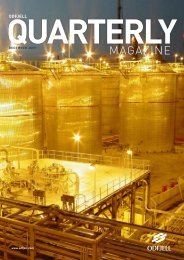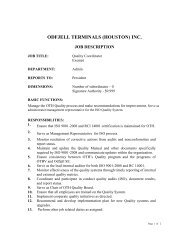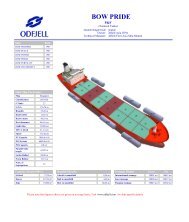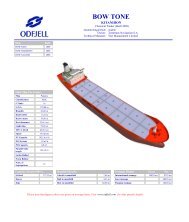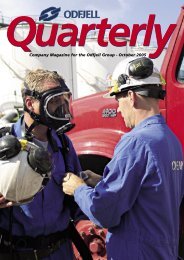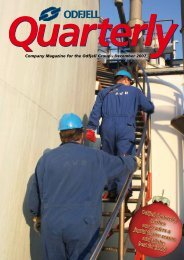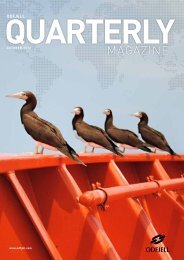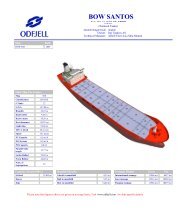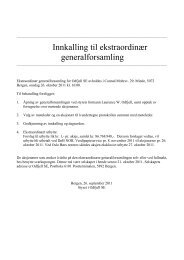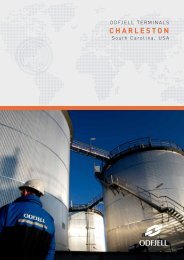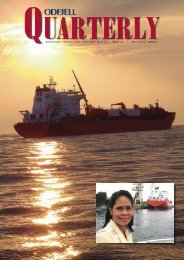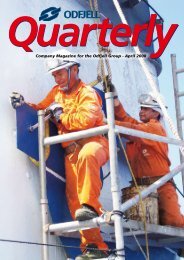Odfjell SE Annual Report 2012
Odfjell SE Annual Report 2012
Odfjell SE Annual Report 2012
Create successful ePaper yourself
Turn your PDF publications into a flip-book with our unique Google optimized e-Paper software.
Energy-saving campaign<br />
In <strong>2012</strong> an internal campaign was launched encouraging<br />
all <strong>Odfjell</strong> employees to suggest energy-saving initiatives<br />
where the best proposals received awards. Several of the<br />
proposals will be initiated in 2013.<br />
Environmental impact of the <strong>Odfjell</strong> fleet<br />
In <strong>2012</strong> the <strong>Odfjell</strong> fleet consumed 569,000 tonnes of fuel<br />
oil, of which 22,000 tonnes were marine distillates. Based<br />
on the consumption of 104 vessels, total emissions of<br />
CO 2<br />
amounted to 1,774,000 tonnes, which represents a<br />
4% increase in shipping-related emissions compared to<br />
2011. Total emissions of SO X<br />
rose 0.8% to 27,619 tonnes,<br />
reflecting the increased operated fleet. All fuel purchased<br />
by <strong>Odfjell</strong> is tested by the third party company Det Norske<br />
Veritas Petroleum Services (DNVPS). Test results on the<br />
fuel purchased in <strong>2012</strong> revealed a sulphur content of 2.44%,<br />
compared with 2.54% in 2011. The global limit in <strong>2012</strong><br />
outside ECA was 3.5%.<br />
<strong>Odfjell</strong> has a Fleet Performance Group which supervises<br />
voyage optimisation/ocean routing, fleet tracking, and<br />
analyses speed, consumption and emissions of all ships<br />
on a daily basis using a well-established performance<br />
monitoring system.<br />
SO X<br />
emissions<br />
Based on all consumption in <strong>2012</strong> (both at port and at<br />
sea), <strong>Odfjell</strong>`s vessels emitted on average 0.27 grams<br />
per tonne cargo transported per nautical mile. This was<br />
slightly below 2011 levels.<br />
CO 2<br />
emissions<br />
In 2009 IMO issued guidelines for the voluntary application<br />
of an Energy Efficiency Operational Indicator (EEOI), defined<br />
as the amount of CO 2<br />
emitted per unit of transport work.<br />
Since 2008 <strong>Odfjell</strong> has calculated the EEOI at ship and fleet<br />
level in accordance with IMO MEPC Circular 684. In <strong>2012</strong><br />
the EEOI for the <strong>Odfjell</strong> fleet was 17.48 grams of CO 2<br />
per<br />
tonne cargo transported one nautical mile (g/tnm). This<br />
was a slight improvement compared with 2011. The EEOI<br />
for the main ship groups sorted by deadweight is shown<br />
in the table below.<br />
Speed/consumption reduction scheme<br />
In <strong>2012</strong> <strong>Odfjell</strong> Tankers operated between 40 and 50 ships<br />
in slow-speed mode. This generated a net fuel saving of<br />
about 90,000 tonnes, which corresponds to emissions<br />
savings of approximately 280,000 tonnes of CO 2<br />
and 4,400<br />
tonnes of SO X<br />
. With the current fleet composition and speed<br />
mode, we expect to see similar savings in 2013. 28 of our<br />
ships are currently being considered for further speed/<br />
consumption reductions.<br />
External weather routing<br />
Advanced weather routing services have been used on the<br />
Company’s owned and time chartered ships since 2009<br />
and around 900 voyages used the service in <strong>2012</strong>. This is<br />
expected to have given a 45 day saving, which corresponds<br />
to about 5,000 tonnes of CO 2<br />
.<br />
Intermediate hull cleaning and propeller polishing<br />
In <strong>2012</strong> hull cleaning and propeller polishing were also<br />
carried out between scheduled dry-dockings. All <strong>Odfjell</strong>operated<br />
ships, both time chartered and owned, are closely<br />
monitored and cleaning intervals are shortened if required.<br />
This type of intermediate cleaning results in a significant<br />
reduction in fuel consumption and subsequent emissions.<br />
Speed increases of up to 18% have been reported on precleaning<br />
consumption.<br />
EEOI CO 2<br />
emissions<br />
Gram CO 2<br />
per tonne cargo transported<br />
1 nautical mile (main ship groups)<br />
70<br />
60<br />
50<br />
At sea<br />
Total<br />
40<br />
30<br />
20<br />
10<br />
0<br />
4–6 000<br />
DWT,<br />
9 vsls<br />
8–17 000<br />
DWT,<br />
19 vsls<br />
20–25 000<br />
DWT,<br />
18 vsls<br />
30–37 000<br />
DWT,<br />
25 vsls<br />
40–51 000<br />
DWT,<br />
33 vsls<br />
All fleet,<br />
104 vsls<br />
77<br />
odfjell annual report <strong>2012</strong>



